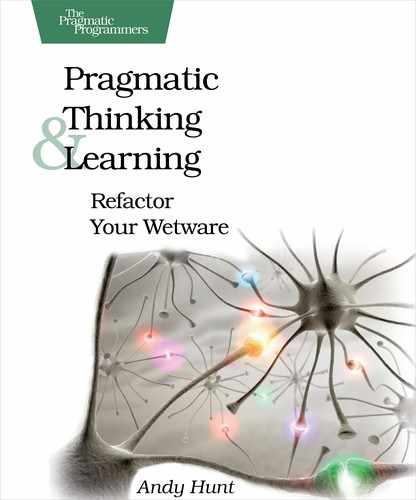Turn Up the Sensory Input
The simplest thing you can do to begin to involve more of your brain in problem solving and creativity is to activate more neural pathways than usual.
That means expanding sensory involvement—using different senses than usual. It’s not a small effect; one study showed a 500 percent improvement for students using multisensory techniques.[49] Even surprisingly simple things can help.
For instance, try fiddling with a paper clip or some sort of tactile puzzle while stuck on a tedious conference call or while pondering a tricky problem.
| Recipe 12 | Add sensory experience to engage more of your brain. |
I’ve seen development teams have good success using tactile enhancement. Instead of trying to create and document a design or architecture directly in a commercial tool (using UML or something similar), use building blocks. Toy blocks. In assorted colors. Or Lego bricks.
Object-oriented design with Lego bricks is quite effective with a group of people: everyone can participate without fighting for the keyboard or the whiteboard marker; you can animate the actions and behaviors easily, and it encourages multisensory involvement. It helps you visualize—and generate imagery of—the proposed workings of the system. CRC cards[50] also have good cross-sensory, tactile properties.
The next step is to emphasize cross-sensory feedback. Involving one extra sense is a good first step; now involve several other senses and allow them to interact. Suppose you take the design and do a couple of things to it:
Use cross-sensory feedback.
-
Write it down in your usual form.
-
Draw a picture (not UML or an official diagram; just a picture). What visual metaphor is appropriate?
-
Describe it verbally.
-
Engage in open discussion with your teammates; respond to questions and criticisms, and so on.
-
Act out the roles involved. (Any physical metaphors come to mind? We’ll talk a lot about metaphors shortly.)
That last idea is quite powerful (and we’ll see it again a bit later); see the sidebar Role-Playing for a real-life example.
Notice that these activities begin to involve additional senses and styles of interaction. When you involve an additional input mode, you are activating more areas of the brain—you’re bringing more processing power online, as it were.
Primary school educators have known for a long time that cross-sensory feedback is a very effective way of increasing understanding and retention. It’s a pretty well-established pedagogical technique. That’s probably why you were forced to create that dreaded diorama of ancient Rome or the papier-mâché model of Pompeii in grade school.
Your brain is always hungry for this kind of additional, novel stimulus. It’s built to constantly adapt to a changing environment. So, change your environment regularly, and feed your brain. Any sort of extrasensory involvement is probably helpful, whether it’s a long walk though crunchy leaves with your dog, opening your window and listening to the day’s weather (and actually smelling some fresh air!), or just walking to the break room or down to the gym (the air there is less fresh, but exercise is also very helpful for better brain function).
Feed your brain.
